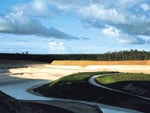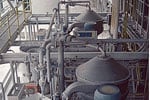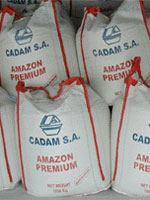Kaolin production in the Amazon jungle
The extremely remote location of its raw material source does not prevent Cadam in Brazil from developing its kaolin production into an increasingly successful business.
DATE 2566-11-28 AUTHOR Lars Klein and Birgitta LundbladAfter a one-hour flight in a northwesterly direction from Belem, located at the mouth of the Amazon river, the arrival at Monte Dourado is an exciting experience. The aircraft flew over the Amazon jungle with its breathtaking beauty and, during the flight, only small native villages could be seen close to the big river. In this remote area it is surprising to find a major industry like Cadam S.A., Brazil’s largest producer of kaolin for coating paper.
 Reginaldo Campos de Souza, Process and Development Manager, agrees that Cadam is located in a remote area with many challenges, but he also points out that this is an inspiring and unique environment that needs to be protected. Cadam has succeeded in combining a prosperous business with environmental conservation and beneficial development of the region. The company is a fast growing producer of kaolin with an annual production of 750,000 tons, which is exported mainly to Europe, Asia and South America.
Reginaldo Campos de Souza, Process and Development Manager, agrees that Cadam is located in a remote area with many challenges, but he also points out that this is an inspiring and unique environment that needs to be protected. Cadam has succeeded in combining a prosperous business with environmental conservation and beneficial development of the region. The company is a fast growing producer of kaolin with an annual production of 750,000 tons, which is exported mainly to Europe, Asia and South America.
Social responsibility
Reginaldo – in Brazil everyone is called by their first name – explains that one of the main reasons for their success is the fact that Cadam has taken a great responsibility for the entire society and provides both basic education and health care for the workers community.
The company also constructs and maintains housing, leisure areas, sport facilities, shopping centres etc. “This is a very remote area without an established infrastructure. If you have the ambition to succeed here, you have to look after your people and the infrastructure. Cadam is increasingly investing in the quality of life of its employees and their families”, he says. “This it is a basic condition for a well functioning operation.”
The business here started about 30 years ago originating from a dream of Daniel Ludwig, an American visionary millionaire. He implemented villages, roads, a power station and everything else needed to run a business including a big food farm, a eucalyptus plantation for pulp production, a pulp mill – and Cadam.
Mr. Ludwig is not running the business any more and Cadam is now a brand in the mind of all paper producers.
Naturally, the existing clay with its valuable natural qualities is an important reason for Cadam being so successful and for keeping ahead of the competition. But the fact that the company has continually improved its production process and had the courage to go for new solutions and methods is also of great importance. “The cooperation with Alfa Laval is one example”, Reginaldo says.“Without this cooperation and the modifications they made of their separators to meet our requirements we would not have had the opportunity to optimize our process”.
Particle size distribution important
 Kaolin is an aluminium silicate formed millions of years ago and deposited in thick layers by the large rivers. The kaolin used by Cadam is from a secondary deposit that is now found where the river met the sea at that time, resulting in a very fine particle size distribution from the outset.
Kaolin is an aluminium silicate formed millions of years ago and deposited in thick layers by the large rivers. The kaolin used by Cadam is from a secondary deposit that is now found where the river met the sea at that time, resulting in a very fine particle size distribution from the outset.
The process of kaolin refining is not complicated but each step of the process needs to be optimized. The raw material is excavated and taken by truck to large blungers in which the material is dispersed in water. A dispersant agent prevents the material from settling in the system. The slurry is taken to a de-gritting stage where the coarse material is removed in strainers and hydrocyclones. It is then transported by gravity through a 6 km ore pipeline to the processing plant.
The next step is to give the slurry the right particle size distribution and remove discolouring particles. This is done in separators from Alfa Laval. “The fine particle size distribution gives our kaolin the high gloss that is required by our customers”, Reginaldo says. “The disadvantage of our raw material is the contamination by various metals. We have spent a lot of effort to overcome these problems, and again Alfa Laval has helped us in finding a well functioning solution.”
A perspective of 250 years

So what are the main challenges faced by Cadam when operating here in the “jungle”? Reginaldo summarizes as follows, Undoubtedly, the infrastructure issues require large efforts and resources from our side. On the other hand, this is the place where the kaolin is, and there is really no alternative to making the best out of the tricky location.
We have been doing this since 1971, and the reserves will last for at least another 250 years. So we intend to continue on the same route where process improvements and product quality are in focus. The main advantage of this location is that our shipping port is located on site, and since distribution is a big part of our total costs, this gives us an advantage over the competition.”
“A major difference in our business environment is the new ownership structure of the company. Recently Companhia Vale do Rio Doce (CVRD), the largest diversified mining company in the Americas, took over the mother company CAEMI. This opens new opportunities, since CVRD intends to increase its kaolin business through Cadam and PPSA, another kaolin company owned by CVRD. We are convinced that the new situation will make us even stronger, particularly since our products are different in character and apply to different customer needs.”
Alfa Laval / Cadam cooperation
Alfa Laval has installed five separators of the type CHQX and CHSX 320 at Cadam. These are used to achieve the fine particle size distribution that gives the kaolin the desirable high gloss.
“Previously, we used 10 decanter centrifuges from various suppliers, and the duty is now performed mainly by the Alfa Laval separators”, says Reginaldo Campos de Souza, Process and Development Manager at Cadam.
“Since the first installation, Alfa Laval has made several modifications of the machines, which now give us many advantages. As they generate high g-forces and have a higher capacity, the production has become very effective. Power consumption as well as maintenance needs have been reduced significantly. Our operators simply love them.”
Alfa Laval has also supplied 10 separators for purifying fuel and lubricating oil for the three power generating diesel engines. In addition, the company has installed a number of plate heat exchangers for different duties including five large units for kaolin slurry.
“Alfa Laval has become the obvious choice for us due to their performance, reliability, service and spare parts support,” says Reginaldo. “We greatly appreciate their continuous willingness to discuss, develop and implement improvements that match our needs.”
